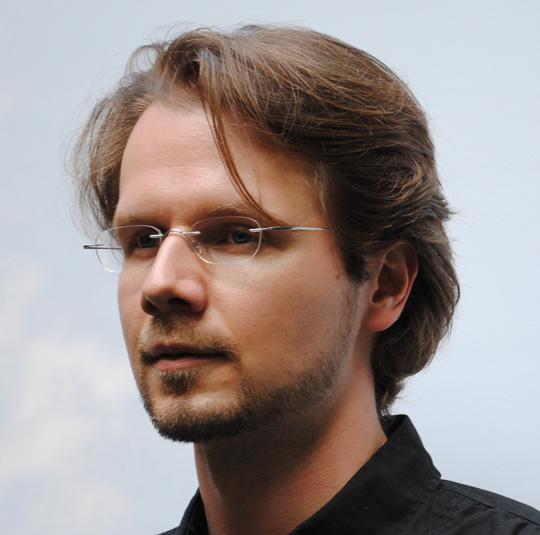Meet the Curator: Steven Matijcio
Posted on July 30, 2018
Steven Matijcio is the FotoFocus Guest Curator behind The Fold: Space, time and the image, featuring Lebanese artist Akram Zaatari, on view at the Contemporary Arts Center October 5, 2018 through February 10, 2019. Here, the CAC curator discusses curatorial instincts and society’s ever-expanding archive.
Akram Zaatari is a photographer, but he also considers himself an archivist, collector, curator, critical theorist, and filmmaker. What can you tell us about his work?
Akram was one of a handful of artists to emerge out of the prolonged Civil War in Lebanon, and this short-lived era of experimentation in the television industry there. There was this newfound freedom to step outside traditional models of art making. During that time he really developed an affinity for amateur photography, studio photography, journalism—these fields that traditionally lay outside of the fine-art canon. So his work is this really compelling, ongoing archaeology that looks at a much broader realm of photographic activity, the performative role of photography, and fashioning identity. He’s less concerned about the documentary integrity of the photograph and really sees it as a “performance of being.” He sees it as an artifact, an object.
For this show, he’s looking at existing, historical, archival materials, but he’ll also be producing some original photographs in this vein.
It’s curious to consider how an artist’s personal history impacts his or her work. How do we see that in Zaatari’s case?
Consider coming out of the Civil War, when there was a great deal of misinformation, fictive narratives, and propaganda circulating. This whole binary of fact and fiction starts to get very blurry. Akram talks about not reading something as black-or-white or one-or-the-other. It’s really the admixture and the confusion between the two that he finds both frustrating as well as inspiring—and the fodder for more exploration.
Misinformation, fictive narratives. That sounds familiar.
We’re in the post-truth era. You can’t just instinctively or intuitively trust a source. It’s gotten more complex. If we’re looking at it from a glass-half-full perceptive, maybe this has made us more active consumers of information.
This year’s biennial theme, Open Archive, is an exploration of why we preserve photography and what we learn by interpreting it. Where does this exhibition fit within that space?
Akram is one of three founders of the Arab Image Foundation, instituted in Beirut. Its mission is to preserve, study, and exhibit photographs from the Middle East, North Africa, and the Arab diaspora from the 19th century to today. He continues to circulate within that realm.
What I find inspiring, intriguing, and vexing about Akram is that he continually questions and deconstructs every institutional model that he works within. He’s interested in looking back at what constitutes modernist photography—so how studio photography fits into an expanded notion of modernist photography, but within this Middle Eastern tradition, where modernism wasn’t aligned with what was happening in the West.
Preservation is such a universal, innately human tendency. This show is an opportunity to ask, “Why do we feel the need to hang onto these things, to preserve them in this way?”
As a society, we are probably adding more to the overarching archive of human activity than ever before. We just generate so much material. With the invention of the cell phone, we can record history at a moment’s notice. This archival impulse has expanded exponentially and yet, are we remembering more? I joke with people that Google has become our surrogate memory. If you can’t quite remember something, just type it in. It’s this endless archive that we have access to at the tip of our fingers.
I’m really fascinated by this massive expansion of archival material, and yet it also kind of destabilizes the entire enterprise. Because what will be preserved? Is everything deserving of preservation? How do we make those value judgments when there’s just this flood of material? We aren’t going to come to any hard and fast conclusions about this, but it’s good we’re having the conversation now, especially when we think about what it means to historicize something.
Everything is so contested today, and I think we’re more conscious of that idea that the victors alone are no longer writing the history for all. That whole idea of a universal perspective has been discredited. And now we’re trying to figure out how to reconcile that large diversity of voices that all experienced a certain event—a narrative—in such different ways. It’s a real tipping point for what the archive will be in the future.
In some ways, a curator is an archivist. What sorts of questions do you ask yourself as you’re putting together a show?
A curator has to listen to their personal instincts. When you go to a biennial, a museum, or an art fair, you’re going to see hundreds of artworks, and then you’re going to come back and ask: What do I remember? What resonates for me? What am I still curious about? But then I need to step outside of my subjectivity and think in a much broader sense: Will this artist or exhibition matter to the broader public?
I live the place that I’m in through a curatorial lens, and so everything around me—the texture of the city, its history, the changing dynamics of demographics—all of those need to inform my perspective. You have to listen to your instincts as much as you listen to the people around you, and what the place is saying. All of those feed into a successful exhibition program. You don’t want an exhibition to be an end point. You want it to be a catalyst, for it to generate thought.
